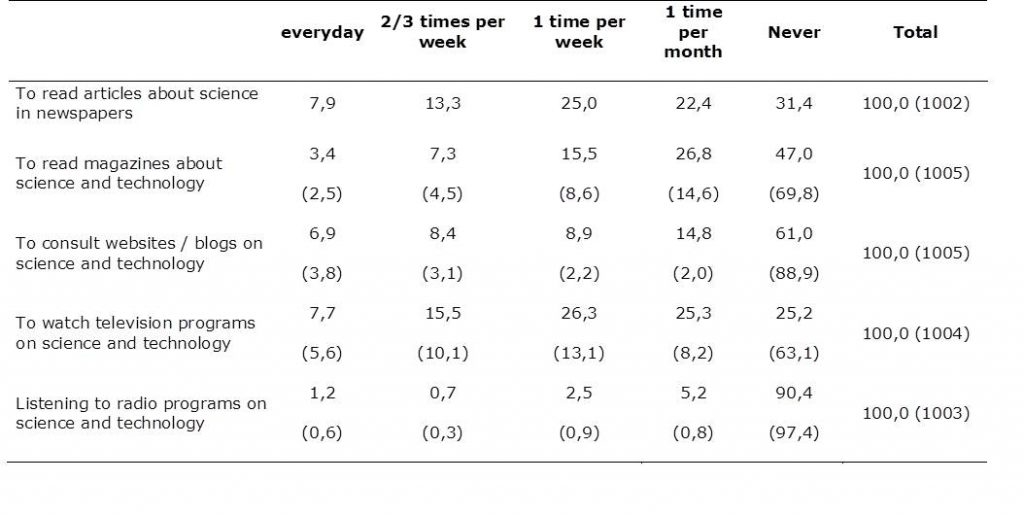Go to the Science and Technology in Society Monitor by Observa.
In 2013 the media most frequently used by Italians to inform about science and technology are: firstly the television, secondly newspapers, thirdly magazines, fourthly Internet sites and blogs, and finally the radio. At least once a week about half of Italians watches television or reads newspaper articles on science and technology, a quarter of interviewees reads magazines or visits websites and blogs, while only 4% listens to radio programs dealing with science and technology.
The percentages just mentioned decrease if we consider only people able to remember the name of at least one TV or radio program followed, one newspaper read or website consulted. Many people, usually occasional users of science in the media, do not indicate the reference of the last media content followed.
The most watched TV programs, whose name is remembered by users, are transmitted by both generalist and thematic channels. The most cited Italian programs are Superquark, Tg Leonardo, Voyager and Geo&Geo; a certain attention is also paid to Sky Discovery and National Geographic and free channels accessible through the digital terrestrial television Focus and DMAX. Very appreciated by those who watch this channel is the program Come è fatto, so underlining the curiosity to the technical production of common use objects.
By far, the most widely read magazine is Focus. To the question “Do you remember the name of the last magazine you read?” 71% of those who reported a name indicated this magazine.
Italians inform about science and technology on the Web mainly through search engines and Wikipedia. Web sites and blogs consulted are frequently cited in news reported in newspapers, magazines, TV or social networks.
Frequency with which Italians follow contents related to science and technology in the media (%)

Note: In parentheses are the percentages of respondents who remember the name of at least one newspaper or program followed.
Source: Observa Science in Society, Osservatorio Scienza Tecnologia e Società 2013, www.observa.it/observa/observa
Data of 2013 seem to indicate an overall increased interest in science and technology issues presented by the various media. As in 2012, the share of who does not ever inform about science and technology decreases. For some media such as newspapers, television, magazines and radio, the low exposure trend reverses. Compared to 2011, the year when it was found the lowest interest from citizens, regular readers of daily press and regular viewers of programs on science and technology grow by 10% and the percentage of Italians who read magazines of scientific dissemination at least once a week increases by 5%. For websites dedicated to science and technology, the increase of users is constant over the years: always more citizens are not satisfied with what is being proposed and look for more scientific information on web.
If the increase in the interest about TV programs dedicated to science and technology is due to the diffusion of free channels, perhaps the increase in the use of newspapers and magazines can be linked to the explosive growth of the web. Even considering the open responses provided, it is likely that a proportion of those who read news on science and technology in the papers does it online.

Occasional and frequent exposure to science in the media. Comparison 2007-2009-2011-2013 (% of respondents who remember the name of the magazine or program followed; 2009: n=1020; 2010: n=985; 2011: n=1001; 2013: n=1005)
Source: Observa Science in Society, Osservatorio Scienza Tecnologia e Società 2013, www.observa.it/observa/observa
The research of science and technology issues through the media reveals a few interesting variations according to age and educational level of respondents. Italian people exposure to scientific contents from media decreases with the age and increases with the level of education. In general, younger and more educated people use more frequently all five media, but differences are particularly relevant in the case of Internet, magazines and newspapers, while television appears to be still able to cover differently aged audiences.
Since 2002, the Science and Technology in Society Monitor has been the first permanent observatory on the attitudes of Italian public opinion towards research and technological innovation. The observatory is an initiative of Observa Science in Society, with the support of the Compagnia di San Paolo.
CATI survey conducted on a sample of 1.001 subjects, stratified by gender, age and geographical area of residence, representative of the Italian population aged 15 and over.
Observa Science in Society is a non-profit, independent, legally recognized research center promoting the study and discussion of the interaction among science, technology and society, with the aim of stimulating dialogue among researchers, policy makers and citizens.







